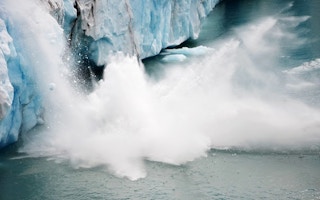Greenland – the largest body of frozen water in the northern hemisphere – is now losing ice seven times faster than it did during the last decade of the 20th century.
From 1990 to 1999, the Greenland ice sheet spilled an average of 33 billion tonnes of ice into the oceans every year. In the last decade the rate of loss has accelerated to an average of 254 billion tonnes a year.
Altogether, the Greenland ice cap has surrendered 3.8 trillion tonnes of ice since 1992. This alone is enough to raise global sea levels by 10.6 millimetres.
Glaciers and icecaps are in retreat in two hemispheres, and on every continent, as a consequence of profligate human combustion of fossil fuels, to drive up greenhouse gas levels in the atmosphere, and accelerate global heating.
Devastating
“As a rule of thumb, for every centimetre rise in global sea level another six million people are exposed to coastal flooding around the planet”, said Andrew Shepherd of the University of Leeds in the UK.
“On current trends, Greenland ice melting will cause 100 million people to be flooded each year by the end of the century, so 400 million in total due to all sea level rise. These are not unlikely events of small impacts; they are happening and will be devastating for coastal communities.”
Professor Shepherd is one of 96 polar scientists from 50 international organisations in a partnership known by the cumbrous name IMBIE, which stands for Ice Sheet Mass Balance Intercomparison Exercise. They made this assessment, based on data from 11 satellite missions and 26 separate surveys between 1992 and 2018, and published their conclusions in the journal Nature.
Greenland is not just the largest ice mass in the Arctic, it is probably the polar landscape studied for the longest time, and the most intensively. Researchers have monitored the rate of summer melt, tried to match increases with other phenomena – for instance the darkening of snow by sub-Arctic wildfires – and tried to explore the mechanisms by which volumes of water that might in the past have frozen again each winter now accelerate glacier melt and escape into the ocean.
“
On current trends, Greenland ice melting will cause 100 million people to be flooded each year by the end of the century, so 400 million in total due to all sea level rise.
Andrew Shepherd, professor of Earth Observation, University of Leeds
No surprise
The icecap is so big that – were it all to melt, which would take centuries – it would raise sea levels by as much as seven metres.
The news of a dramatic increase in rates of melting is not a surprise, and certainly not to the people who live in Greenland.
In 2013, the Intergovernmental Panel on Climate Change warned that global sea levels would rise by 60 cms by 2100. What matters about the latest survey is that it confirms the worst fears of many climate scientists and suggests that sea level rise is heading for the high end of the 2013 projections.
That is, by the end of this century, seas could have risen by nearer 70 cms. Around 100 million people already live at levels below the highest tides: the numbers increasingly at risk may be much higher.
The same study also explores the rates of change. Although the warmest years ever recorded have happened in the last century, as fossil fuel emissions and rainforest losses have continued to increase, the impact of global heating has been uneven.
The greatest loss of Greenland ice in any one year was in 2011, when the island lost 335 billion tonnes. Nor does the survey include all the data from 2019, and researchers could yet find that this summer’s ice loss has set new records.
Greenland’s loss of ice has been mirrored by continued loss of sea ice during successive Arctic summers, and since the world’s seasonal weather patterns have – for most of human history – been driven by the temperature difference between tropics and poles, the continued loss of ice will almost certainly impose worldwide costs in harvest losses, freak storms, droughts, wildfires and of course coastal flooding.
And ultimately, the study is a test of computer simulations of change in the northern hemisphere. Climate models have consistently predicted polar ice loss and sea level rise. But the latest study is a confirmation that such loss is real, and beyond argument.
“While computer simulation allows us to make projections from climate change scenarios, the satellite measurements provide prima facie, rather irrefutable evidence,” said Erik Ivins of Nasa’s Jet Propulsion Laboratory in California, and a co-author.
“Our project is a great example of the importance of international collaboration to tackle problems that are global in scale.”
This story was published with permission from Climate News Network.










